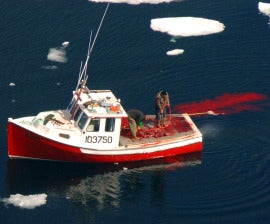The true economic value of Canada's commercial seal hunt stands in sharp contrast to the high level of financial and other support it receives from the Canadian government. As the following government statistics show, the commercial seal hunt is an economically marginal activity, and its negligible value could be easily replaced by the federal government.
The sealers
Sealing is an off-season activity conducted by a few thousand fishermen from Canada's East Coast, who participate in several commercial fisheries throughout the year. They earn, on average, a very small fraction of their total incomes from sealing—the rest from other fisheries such as crab, shrimp and lobster.
Notably, Newfoundland's fishing industry has never been wealthier in history, today earning at least $150 million more each year than it did prior to the 1992 cod collapse. Individual fishermen earn an average of 50 percent more than they did in 1991. This wealth is due almost entirely to the shellfish industry, which today accounts for 80 percent of the value of Newfoundland's fishery. Income from sealing, in contrast, brings in only two percent.
Value of the seal hunt to the economy
Fishermen from Newfoundland kill more than 90 percent of the seals slaughtered each year. But even in Newfoundland, sealing income accounts for less than one tenth of one percent of the Gross Domestic Product.
The Newfoundland government estimates there are about 400 people engaged in the processing of seal products, on a seasonal, part time basis. But the handful of seal processing plants that operate in Canada are heavily subsidized by the Canadian government, which provides grants and interest free loans for capital costs and employee salaries through at least two federal funding programs: the Atlantic Canada Opportunities Agency and Human Resources Development Canada.
Value of the seal hunt to individual sealers
The Newfoundland government indicates there are 4000 active sealers, while the Canadian Sealers Association says there are only 2500 (http://www.norden.org/pub/miljo/miljo/sk/2001-580.pdf, page 57). Assuming there are 4000 sealers, out of a population of half a million people, less than one percent of Newfoundlanders participate in the seal hunt.
Government data shows sealers earn on average less than five percent of their total annual incomes from sealing—the rest from commercial fisheries. This analysis is supported by quotes from sealers in recent media reports (National Geographic, 2003).
Commercial sealing license retirement plan
In the past year, effective consumer action campaigns have been launched targeting Canada's fishing and tourism industries with the goal of ending the seal hunt. Those campaigns have gained international public and corporate support, causing concern to both industry sectors.
Opinion polling shows public opposition to the commercial seal hunt is escalating, and governments are taking action on behalf of their constituents. Several European countries are currently working to ban the trade in seal products, and governments in the United States, Britain, Italy, the Netherlands, Poland, and other countries have conveyed their concerns to Canada.
It is clear continuing the seal hunt may simply not be worth the risk to other industries and Canada's international reputation.
The commercial seal hunt provides few economic returns for a limited number of people. Moreover, the work itself is difficult, dangerous and dehumanizing, and often results in costly damage to fishing vessels. These factors make a license retirement scheme an attractive way for the Canadian government to end the commercial seal hunt while offsetting any economic impact associated with the decision.
Successful license retirement programs have been implemented over past decades in Canada, the United States, Britain, Europe, Australia and elsewhere in the wake of fisheries closures and reductions. These programs can take many forms, but generally involve providing federal funds in exchange for fishing licenses.
In comparison to the four billion dollars provided by the Canadian government in recent years for fisheries diversification and license/vessel buy-back programs, the money required for a sealing license retirement program seems entirely reasonable.
